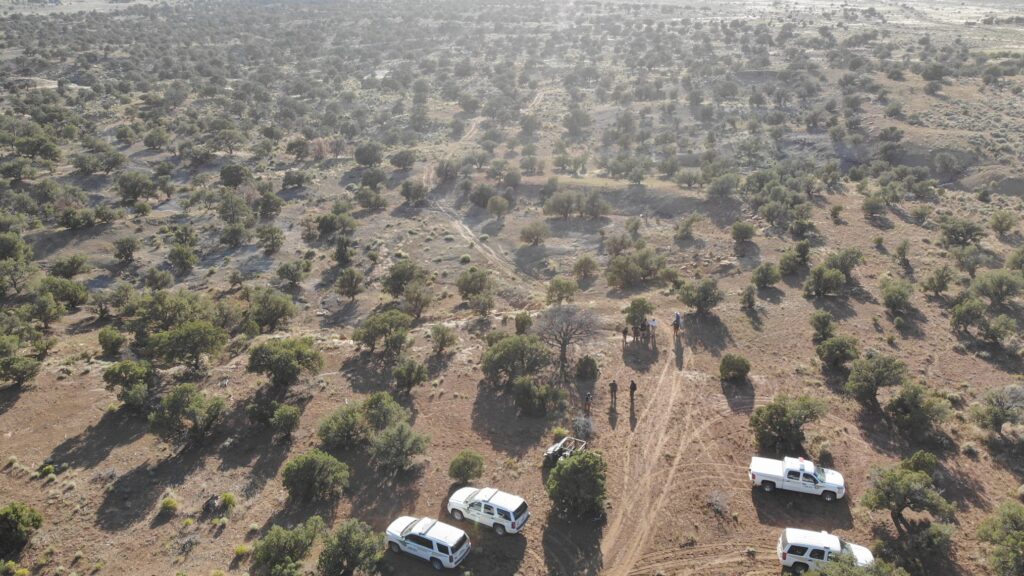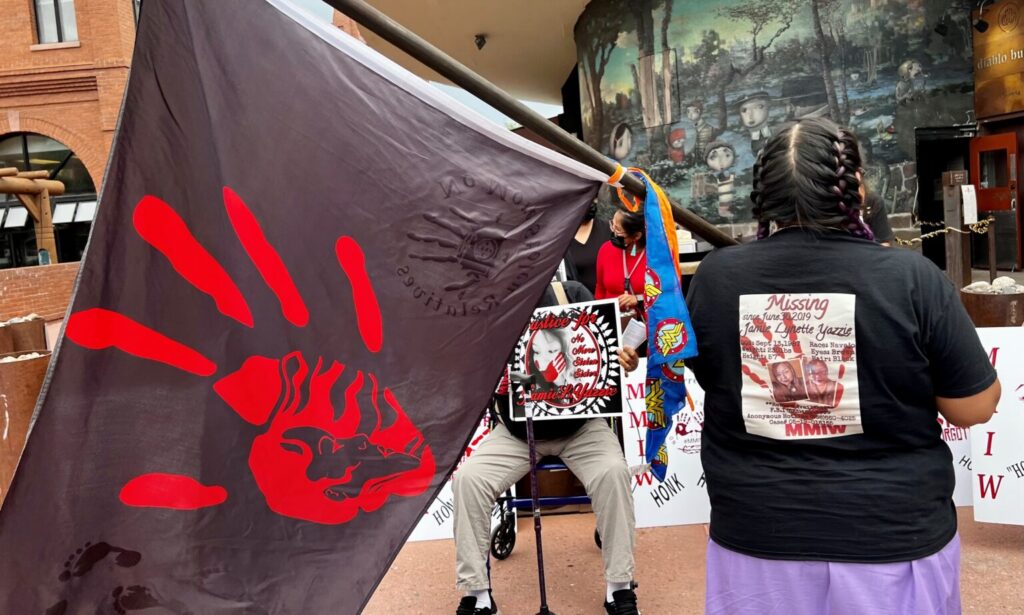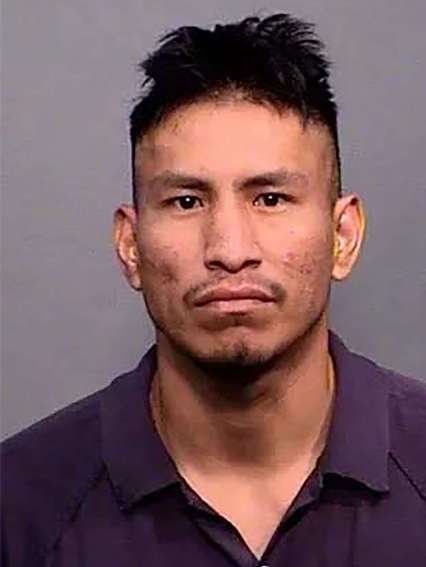When a nursing assistant goes missing on the Navajo Nation, her friends and family refuse to give up hope. What happened to Jamie Yazzie?
Episode Media





Episode Sources
- FBI looking for woman missing within the boundaries of the Navajo reservation
- Navajo Police seek public’s assistance in locating missing woman
- Search for Jamie Yazzie suspended
- Police renew search for missing woman
- FBI Seeking Information on Missing Woman
- Crowd rallies for missing and murdered Indigenous women
- We want Jamie home: After two years, family still looking for answers
- What happened to Jamie? Missing Navajo woman found dead, FBI investigating
- FBI seeks info after missing Navajo woman’s remains found over 2 years after disappearance
- Pinon Man Arrested for Alleged Murder of Missing Navajo Woman and Acts of Domestic Violence
- Arizona man suspected of killing Navajo woman
- Tre C. James Murdered Jamie Yazzie in Arizona: Feds
- United States v. James, 3:22-cr-08073
- US v Tre James – Criminal Complaint and Indictment Aug 2022
- ‘It’s starting our healing process’: Navajo family of murdered woman seeks justice
- Healing blanket offers rejuvenation, Hózhó for grieving families
- True Crime Arizona Documentary: The Forgotten
- Jamie Yazzie’s family led to location of remains found following ‘The Forgotten’ documentary
- Day one of high-profile Jamie Yazzie murder trial
- Pinon Man Found Guilty of Murder of Missing Navajo Woman
- Jamie Yazzie’s boyfriend found guilty in her murder
- Verdict reached in murder trial for Jamie Yazzie
- A Navajo woman’s disappearance ends in a murder conviction
- Justice for murdered Navajo woman, Jamie Yazzie, finally served in Phoenix
- Missing and Murdered Indigenous Women and Girls Report
- IHS is Raising Domestic Violence Awareness and Prevention Efforts in Indian Country
Episode Transcript
Welcome back to Bite-Sized Crime. This week I’m bringing you the story of a woman trapped in a dangerous relationship she couldn’t escape, whose family never gave up hope that she would come home, waiting years for justice. This episode discusses sensitive topics, so listener discretion is advised.
On Friday, July 5, 2019, Ethelene Denny called the Navajo Nation Police Department and asked to file a missing persons report. She hadn’t been able to get in contact with her daughter for days, and she was convinced that something bad had happened.
Her daughter, 31-year-old Jamie Yazzie, was a nursing assistant who worked long hours at the health center in their tiny town of Pinon, Arizona. Jamie was also the mother of three young boys whom she adored. The boys lived with Ethelene full-time, while Jamie worked at the clinic in the hopes of one day providing a better life for her sons. But even though Jamie didn’t live with her children, she still saw them multiple times a week and called and texted every day. That’s why it was so surprising to Ethelene when, at the end of June, Jamie stopped answering the phone; all her calls were suddenly going straight to voicemail.
Ethelene tried contacting the health clinic, even stopping by in person to ask if they had seen Jamie, but each time they told her that Jamie wasn’t there. Ethelene asked them to tell Jamie to call her, to let her know that she had stopped by. But days passed, and she didn’t hear a thing.
Then, she got a phone call. Jamie’s coworkers at the health center had finally realized that they hadn’t seen Jamie in a week; she hadn’t shown up for any of her shifts, which was extremely unlike her.
When Ethelene heard this, she knew she had to call the police. What she didn’t know was that someone else was also contacting the police. A health center employee had found Jamie’s car less than a mile from the clinic. They told the responding officers exactly what they had told Ethelene – Jamie hadn’t been to work in a week, and now her car had been found abandoned.
Officers from the Chinle District of the Navajo PD began searching the immediate area where the car was found, but there were no obvious clues indicating where Jamie could have gone. Soon, the search had expanded to the vast desert surrounding the town, with community volunteers joining teams from the Department of Emergency Management and the Navajo Department of Criminal Investigation. Unfortunately, the extensive search yielded no results, and on July 12th, the search effort was officially suspended.
But even though the ground search had stopped, the investigation into Jamie’s disappearance had not. Detectives from the Department of Criminal Investigation had been interviewing Jamie’s family and friends, putting together a timeline of her last known movements.
Jamie’s last contact with anyone had been on Sunday, June 30th, five days before she was officially reported missing. She had made several calls to family members, and she had texted a co-worker asking for a ride to work on Monday. The co-worker told police that Jamie hadn’t shown up, so they had assumed that she had changed her mind. But Jamie didn’t show up for work that day, nor any of the days after that.
Investigators tracked down everyone Jamie had spoken to in the days prior to her disappearance, including her estranged husband. According to court documents, Jamie and her husband – who was also the father of her three children – were in the process of a divorce, and he had been locked up in the Chinle jail when Jamie vanished. When detectives interviewed him, he said that he talked to Jamie on the phone almost every day, and had even talked to her on June 30th, but he hadn’t noticed anything out of the ordinary. However, he did tell investigators that Jamie had a boyfriend, and that boyfriend was cheating on her.
Jamie had been in a relationship with 27-year-old Tre James since March of 2019. Tre lived in a small blue house in Pinon, and Jamie often stayed with him. But while Jamie told everyone that she and Tre were deeply in love, that he looked out for her and took care of her, the truth was much darker. According to friends and family members, Jamie and Tre fought constantly, especially when they were drinking, and it often escalated into violence. Jamie would go stay with Tre’s aunt for a few days until things calmed down. Then, they would do it all over again.
On the night of June 30th, Jamie picked up her brother and his girlfriend and headed over to the blue house to hang out with Tre. But while the three visitors sat in the living room, drinking and laughing, Tre stayed in his bedroom. Jamie bounced back and forth between the bedroom and living room, making conversation and getting more and more tipsy as the night went on.
Jamie’s brother told investigators that at one point, Tre called him back to the bedroom to show him his new handgun, a silver and gray 9mm. Jamie joined them in the bedroom, telling her brother that Tre had pointed the gun at her and had tried to shoot her with it. Her brother was surprised and told Tre to never do that again, but Tre acted like it was no big deal: they had just been playing around and he had accidentally pulled the trigger.
Soon, Jamie and Tre were in a full-blown argument. Jamie accused Tre of cheating on her and threatened to leave him; his sister had caught him with another woman and posted all about it on Facebook. But Tre denied it, saying that Jamie was overreacting. Jamie was angry and hurt by his betrayal and his denial.
The fight continued on into the early morning hours of July 1st, and by 1am, Jamie’s brother and his girlfriend had had enough. They were tired and drunk and wanted to go home. Jamie’s brother told investigators that he thought Jamie would be okay after they left. She and Tre fought all the time, this wasn’t anything unusual.
But by the next morning, Jamie had vanished.
Phone records indicate that Jamie’s cellphone was either turned off or stopped working by 1:13am on July 1st, around the time her brother and his girlfriend went home. There was no further activity on the phone after that. But investigators were even more interested in the fact that Tre had texted Jamie’s phone several versions of “where are you?” throughout the day on July 1st, then suddenly stopped around 1pm. In contrast, Jamie’s friends and family had messaged her dozens of times starting July 2nd with no response.
Tre’s sister told investigators that after July 1st, Tre spent a few days at his aunt’s house rather than his own. She said that he was acting “aggressive, nervous, and paranoid”. He had a handgun with him and kept saying he didn’t know where Jamie was. His sister also told investigators that she had gotten several messages from Jamie the day she disappeared saying that Tre had fired his gun twice as he chased her into the house. Tre’s sister recalled how she had warned Jamie about Tre multiple times, telling her to get out of the relationship, but Jamie kept going back, caught in the cycle of abuse.
The more people detectives questioned, the more they became convinced that Tre was responsible for Jamie’s disappearance. His own father told investigators that he believed Tre had killed Jamie. But they needed actual evidence. They needed to find Jamie.
On July 11th, Chinle police officers were responding to a call at an abandoned house when suddenly a woman called out that a man had jumped out the window and was running up the hill behind the house. The officers saw some local kids playing nearby and asked if they had seen a man running past; the kids said that some guy had just jumped into a trash can. Sure enough, when the officers looked inside, there was Tre James, drunk and covered in garbage. He was arrested and charged with public intoxication and criminal nuisance.
While Tre was in police custody, federal agents got a warrant to search his home. In the blue house, they found a 45 caliber pistol, a shotgun, multiple rounds of ammunition, including an empty box of 9mm bullets, and four cell phones. They also discovered what appeared to be blood. There were red stains on the floor tiles, the drywall, and the baseboard in the bedroom Tre shared with Jamie as well as stains in the hallway and the front porch. The queen-sized mattress had been stripped of its bedding and looked as though someone had tried to burn several stained areas. Crime scene investigators collected the evidence and sent it to the FBI laboratory in Quantico for testing.
Then, they waited.
Tre was eventually released from custody after his arrest for public intoxication. Meanwhile, Jamie’s case languished, making little to no progress as the evidence sat in the FBI’s backlog.
In August of 2020, a year after Jamie’s disappearance, the FBI had her missing poster translated into Navajo, hoping it would generate more leads. In April of 2021, they announced a $5,000 reward for information leading to the arrest and conviction of those responsible. Jamie’s family continued to search for her, handing out fliers and attending rallies. Her aunt Marilene told the Daily Lobo, “I put it out there constantly that she’s missing. We want to keep positive and believe that she’s still out there and one day she will come home. But there’s times when I doubt it.”
Finally, in September of 2021, two years after it was sent to the lab, the results from the evidence testing came back. The lab report found that there was “strong evidence” that the blood on the floor tile and the blood on the drywall and baseboard belonged to Jamie Yazzie.
But even with this evidence, prosecutors did not make an arrest. Gary Restaino, the United States Attorney in the District of Arizona, told reporter Briana Whitney that they couldn’t move forward without Jamie’s body. “We’re not going to charge a case unless we have what we call a readily provable case. I trust our team… and our team didn’t feel comfortable charging the case to a standard by which we would prevail at trial… We need the forensic evidence and sometimes it can take a year or two to get the results of forensic evidence back. These cases are difficult not just because of the forensics but because we sometimes have to find the human remains before they can even be tested.”
And so, they kept waiting.
In November of 2021, Jamie’s aunt Marilene had a dream in which Jamie appeared to her and led her to a large rock formation in the desert just across the border between the Navajo Nation and the Hopi Reservation. When Marilene woke up, she and her sisters immediately drove to the Hopi Reservation, led by Marilene’s memory, and found the rock formation she had seen in her dream. There, on the ground, they found Jamie’s wallet, its dark brown leather camouflaged in the dirt.
When they turned the wallet over to the FBI, the agent at the field office asked how they had known where to find it. The sisters thought the response was odd, but they brushed it off. Three months later, it would finally make sense.
In March of 2022, authorities announced that they had found the body of 31-year-old Jamie Yazzie. Her remains were identified through dental records, and the family was notified.
But the timeline of the discovery was incredibly upsetting for Jamie’s family. According to the True Crime Arizona documentary, Jamie’s remains were actually found on November 23, 2021 – one week before Marilene had the dream and discovered Jamie’s wallet at the rock formation, the same rock formation where the FBI had found Jamie. However, the family was not told of the discovery for three whole months. In fact, they had reached out to the FBI in January of 2022 and asked for an update, but were told that there was no new information to share. Although the agency claims that they kept the information secret to preserve the integrity of the investigation, I can’t help but think that it is exceptionally cruel to keep that kind of truth from a grieving family.
To add insult to injury, Tre James was still roaming free. Investigators had interviewed him again in January of 2022, but they didn’t make an arrest. Tre told the detectives that he and Jamie never fought, that he had never owned a gun. He didn’t know where she was or what had happened to her.
Finally, in August of 2022, three years after Jamie was killed, Tre James was arrested and charged with first-degree murder. He was also charged with multiple counts of domestic violence. While investigators and prosecutors waited to build their case against him, Tre James had carried on as usual, assaulting, strangling, and nearly killing at least three other women.
The arrest documents alleged that in the early morning hours of July 1st, Tre James shot Jamie Yazzie in the back of the head with a 9mm pistol. He then wrapped her in a blanket and a blue tarp and drove to the Hopi Reservation where he dumped her body in the desert.
At a court hearing on August 12th, Jamie’s family packed the courtroom, ready to share their victim impact statements with the judge. Marilene read a statement written by Jamie’s mother. “Tre James didn’t give my daughter a chance to enjoy life with her loved ones. Tre James is the reason why Jamie lost time with her sons, and he is why they will never know or feel their mother’s love, hugs, or pride in them again.” The judge ruled that Tre would remain in federal custody until his trial.
In September of 2023, Tre James finally went on trial for the murder of Jamie Yazzie. The prosecution presented the blood evidence and cell phone data, and many witnesses took the stand to share their stories. The trial lasted seven days, and at the end, the jury found Tre James guilty on all counts. He is scheduled to be sentenced in January of 2024, where he faces a mandatory life behind bars.
After the verdict, U.S. Attorney Gary Restaino told the press, “Vindicating the rights of missing and murdered indigenous persons requires all the energy and compassion we have. That means not only investigation and prosecution of tough cases, but also community engagement, cultural competence, and active listening to next of kin and other family members.”
Jamie’s family was overjoyed by the jury’s decision. Ethelene told KOAT News, “I’m so happy that I got justice for my daughter. And I’m pretty sure she’s watching over us.”
Darlene Gomez, the family’s attorney, told the Phoenix New Times, “For all these years, victims have been invisible. Even after this trial, we still are invisible. But luckily for this case, we were visible, and they listened to us.”
Studies have shown that domestic violence disproportionately affects Native communities. According to the National Institute of Justice, more than 80% of indigenous people in the United States have experienced violence in their lifetime, with 55% of indigenous women experiencing physical violence by an intimate partner. Homicide is the third leading cause of death for indigenous women, ten times higher than the national average. Jamie Yazzie deserved to be safe from violence, deserved to go home to her children, deserved to live.
As of this recording, Jamie’s family is still waiting for her remains to come home. Once they are released, the family plans to have a proper ceremony to honor her memory.
As we come to the end of National Domestic Violence Awareness Month, I want to encourage you once again to reach out if you need help for yourself or someone you know. The National Domestic Violence Hotline is available 24/7 and is free and confidential. You can call 1-800-799-7233 or text START to 88788.
